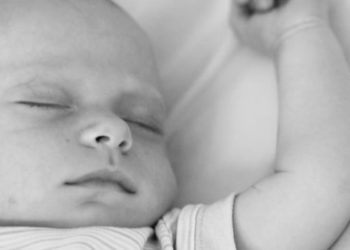Prone sleeping position and heavy bedding associated with SIDS [Pediatrics Classics Series]
Image: PD
1. In a study of sudden death in infants compared to matched controls, a significant increase in risk of death from unknown causes also called sudden infant death syndrome (SIDS) was observed among infants who slept prone as opposed to sleeping on their side or supine.
2. A significant increase in SIDS risk was seen among infants who were wrapped in more blankets, wore heavier clothing to bed, or were in a home that was heated overnight when compared to control infants.
Original Date of Publication: July 1990
Study Rundown: In the context of research associating heat with sudden infant death syndrome (SIDS) and the observation that countries with warm climates and infants who sleep supine have low incidences of (SIDS), this study aimed to further elucidate the role of sleeping position, bedding, and environmental temperature in sudden infant death. Researchers found that prone position during sleep, heavy bedding/bed clothing, and overnight heating in homes significantly increased the risk of infants dying from SIDS. The study was limited in its generalizability through use of a study population from one specific geographic location. Despite this, the study further supported the theories that SIDS deaths commonly resulted from prone infant position and increased infant heat exposure. Following this study and multiple other publications supporting findings regarding sleep positioning, the United States and many other countries initiated “Back to Sleep” campaigns now known as “Safe to Sleep,” encouraging caretakers to place infants in the supine position to reduce SIDS incidence. Significant reductions in SIDS have been seen following these campaigns. While side sleeping has not been identified as a SIDS risk factor, it is discouraged by pediatricians as infants can roll over from their sides onto their bellies. In addition, further work has identified other SIDS-associated risk factors including loose bedding, soft sleeping surfaces, and bed-sharing.
Click to read the study in British Medical Journal
In-Depth [case-control study]: All sudden infantile deaths in 2 counties of England were reported and, for each infant, 2 control infants living in the same neighborhood were identified. Researchers visited the bereaved families soon after death and on several other occasions during the following months in order to gather a full social and medical history at the time of death. This included discussing sleeping position, sleep timing, clothing and blankets in the crib, and heating conditions in the room. To assess the heaviness of infant bedding and blankets, the thermal resistance of these materials was calculated and expressed in units of tog, where higher tog indicates heavier materials. Comparable histories were taken for control infants with attention paid to the 24 hours before the research visit. X2 testing along with Mantel-Haenszel tests, and multiple logistic regression models were used to assess the difference between groups and risks associated with sudden death.
A total of 72 infants died suddenly during the study period (mean age = 94.4 days) and a total of 144 control infants (mean age = 97.0 days) were included for comparison. Among the 72 infants who died, 5 were found to have pathologic causes contributing to their deaths, while the remaining 67 had no known cause and their deaths were therefore deemed secondary to SIDS. Among the 67 SIDS cases, 62 infants had been put to sleep in the prone position, while 76 of the 134 control infants slept prone. Prone positioning was associated with an 8.8 times increased risk of SIDS when compared to control infants (relative risk [RR] = 8.8, 95% CI: 7.0-11.0, p < 0.001). Infants who died of SIDS were wrapped in significantly heavier bedding than control infants (9.1 tog v. 8.0 tog, p < 0.05). After controlling for sleep position, a significant increased risk with heavier bedding/heavier bed clothing was observed (RR = 1.14 for each 1 tog increase above 8 tog, 95% CI: 1.03-1.28, p < 0.05). Overnight home heating was seen in significantly more homes of infants who died than controls and was associated with a significantly increased risk of SIDS death (28 of 67 v. 34 of 134, RR = 2.7, 95% CI: 1.4-5.2, p < 0.01).
© 2012-2014 2minutemedicine.com. All rights reserved. No works may be reproduced without expressed written consent from 2minutemedicine.com. Disclaimer: We present factual information directly from peer reviewed medical journals. No post should be construed as medical advice and is not intended as such by the authors, editors, staff or by 2minutemedicine.com. PLEASE SEE A HEALTHCARE PROVIDER IN YOUR AREA IF YOU SEEK MEDICAL ADVICE OF ANY SORT.







